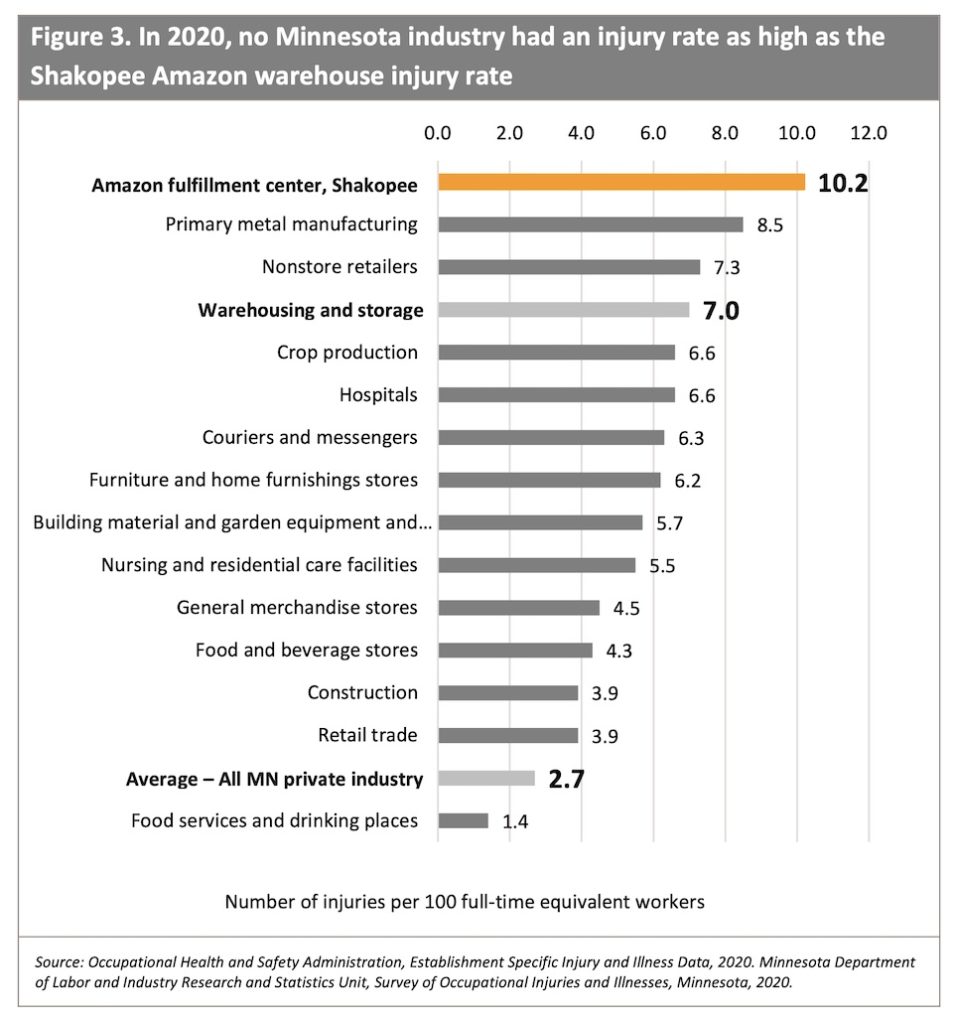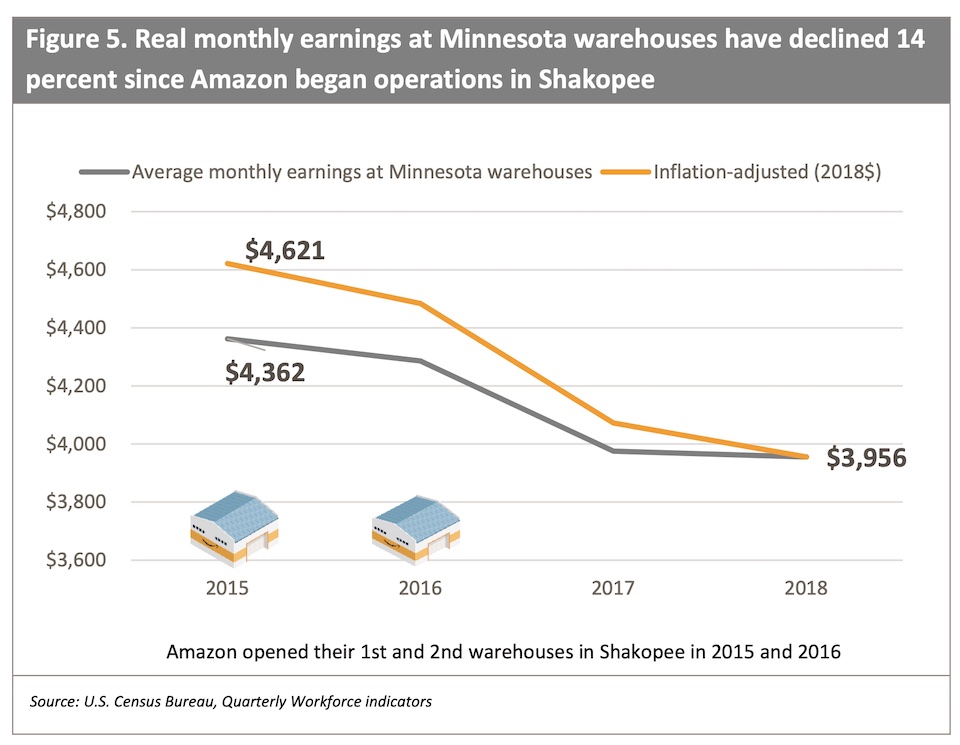KELO-TV looks at the death and destruction wrought by the tornado that wrecked an Amazon warehouse in Edwardsville, Illinois, last Friday and asks whether the warehouse Amazon is building in Sioux Falls will be able to withstand an F3 tornado:
Butch Warrington, the chief building official for the city of Sioux Falls, said in a Dec. 13 interview, “You can’t design for everything, let’s put it that way” [Rae Yost, “Is a Warehouse in Sioux Falls Required to Withstand an F3 Tornado?” KELO-TV, 2021.12.13].
Getting flattened by the occasional tornado may be the least of warehouse workers’ worries when Amazon opens its Sioux Falls facility next year. A new report from the National Employment Law Project finds that workers at Amazon’s two oldest Minnesota warehouses, both in Shakopee, suffer extreme rates of injury, a racial earnings gap, occupational segregation, and triple-digit turnover rates:
Amazon warehouse workers in Minnesota are more than twice as likely to be injured at work as other Minnesota warehouse workers. According to Amazon’s own records from 2018 to 2020, the rate of injuries at its Minnesota warehouse facilities is 11.1 cases annually per 100 full-time-equivalent workers. This is the equivalent of one injury for every nine workers each year—more than double the rate at non-Amazon Minnesota warehouses (5.2) and more than four times the average rate for all private industries in Minnesota (2.7) during the same period….
Black workers are overrepresented in Scott County warehouses (which are mostly Amazon facilities), representing 38 percent of the warehousing workforce and only 8 percent of the total workforce in the Twin Cities…. Additionally, Black warehouse workers’ monthly earnings are only 63 percent of white warehouse workers’ monthly earnings….
Annual turnover at the Shakopee Amazon warehouses is as high as 170 percent. This means that for every job at the Shakopee Amazon facilities, almost two workers left their positions there over the course of a year. By contrast, turnover in Minnesota at non-Amazon warehouses was only about 61 percent [Irene Tung, Maya Pinto, and Deborah Berkowitz, “Injuries, Dead-End Jobs, and Racial Inequity in Amazon’s Minnesota Operations,” National Employment Law Project, 2021.12.08].
If you think farming is dangerous work, try moving to the big city and working for Amazon:

Amazon’s Shakopee workers were more than 50% more likely to get hurt on the job than Minnesota’s crop producers.
Amazon Shakopee’s harms extend beyond its workforce. NELP’s report supports past findings that show Amazon’s wages leave many workers and their families relying on food stamps and drive down wages for the entire warehouse industry:

The public also pays for Amazon’s exploitation in increased infrastructure costs and pollution:
Amazon negotiated to have public money that could have gone to schools and libraries diverted to improvements to roads and highways feeding its Shakopee facilities.
Prior to the construction of its Shakopee sortation and fulfillment centers, Amazon negotiated with Shakopee and Scott County for $5.7 million worth of road-widening and other improvements. The funding came from local and county public funds that typically resource schools and libraries.
The City of Shakopee and Scott County have seen their road maintenance budgets swell since Amazon’s arrival, due to increased truck, van, and car traffic.
Air pollution generated by vehicular traffic around Amazon facilities harms the health of Shakopee residents and contributes to climate change.
In addition to road wear-and-tear, as described above, vehicles that service Amazon’s Shakopee facilities emit air pollutants that are harmful to the health of Shakopee residents, who are disproportionately Black, Latinx, and Asian. Vehicular pollution can cause asthma and bring on asthma attacks—attacks that kill Black Minnesotans at four times and Asian Minnesotans at two times the rate of their white counterparts. Like elsewhere in the country, Amazon’s operations in Minnesota exacerbate environmental injustice [Tung, Pinto, and Berkowitz, December 2021, p. 20].
NELP recommends that Minnesota hold public hearings and dispatch OSHA to investigate Amazon’s warehouses, overhaul Amazon’s inadequate onsite medical care, ban Amazon’s opaque “Time Off Task” practices and require breaks for workers, require Amazon to actually tell its workers what metrics it uses to determine discipline and firings, regulate workplace surveillance, and address racial inequity and abuse of contract and seasonal workers. Chances of South Dakota’s anti-worker, crony-capitalist leaders adopting similar safeguards to protect Amazon’s future laborers in Sioux Falls are slim. Never mind requiring tornado shelters; leaders in Sioux Falls and Pierre will likely leave Amazon free to drive South Dakota workers through the daily whirlwind of physically, mentally, and ultimately socially destructive workplace practices.
Build the building out of thick concrete… One can design for everything; comes down to how much money one wants to spend.
Also, tax breaks for large corporations in the name of jobs is unfair, non – competitive, potentially very damaging to competing smaller companies, and a fom of socialism many Republicans seem to be ok with.
1. Fund OCEA so it can properly police safety regulations in the workforce.
2. Require boards include voting seats for employees.
3. Unionize.
Sorry, fund OSHA — bad morning typo.
Search: Amazon manager told workers they’d likely be fired if they fled the building, before tornado destroyed it.
https://www.nbcnews.com/news/us-news/kentucky-tornado-factory-workers-threatened-firing-left-tornado-employ-rcna8581
A union worker has zero union protection for the first six months and can be fired without a reason being given.
This six months is ample time for management to determine if the future union worker is up to task and will be a benefit to the company.
Once the six month probation period is over a worker must receive a written warning for any violation of company rules and standards.
The worker then has full union representation if they choose to file a grievance against the written warning.
A second offense, of the same violation, can result in dismissal but the worker is still represented if they choose to file a grievance against the dismissal.
Representation entails a union lawyer being present at any meeting between the worker and management.
Warehouse work is tough physical, running on the clock, heavy lifting. The pallets keep coming the entire shift. It is no stroll in the woods. the workers earn every penny and then some.